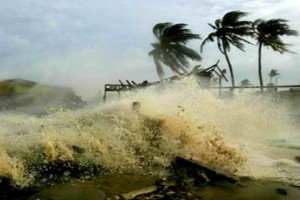Cyclones are typhoons are hurricanes—depending on where you are on Earth. But one thing that has been true since people started keeping good records is that cyclones don’t typically hit the Middle East. Last night, that statement flipped to false. Tropical Cyclone Chapala made landfall on Yemen, flooding coastal regions of the desert nation.
Chapala is supposed to drop a decade’s worth of rain in days; steep mountains along the coastline push its clouds up and its moisture out. And Yemen isn’t accustomed to heavy rain, let alone cyclones. The country averages 2 to 3 inches a year. Chapala could drop more than 20 inches. It’s as if Los Angeles got a nor’easter, or Dallas had a volcanic eruption. “Yemen is not the most well prepared spot for a storm of this magnitude to make landfall,” says Amato Evan, a climate scientist at Scripps Institute of Oceanography in San Diego.
Making matters worse, Yemen barely has a government. The country has been fighting a civil war for the better part of a decade, and it is historically one of the poorest Middle Eastern countries. Unemployment hovers around 35 percent, and Al Qaeda and other insurgent groups control parts of the country. That means little organized response: The rescue and aid work people in, say, South Carolina might expect won’t come. It can’t come. The United Nations, World Health Organization, and Doctors Without Borders are working to fill the gap.
“In modern records, there has never been a tropical cyclone that has struck so far south along Yemen’s coast,” says Bob Henson, meteorologist and blogger at Weather Underground. The Arabian sea is warm enough for storms to form, but too small for them to get very strong. And monsoon season—running from July to September—limits when cyclones can form to a few months in early spring and late fall. If they do form, and if weather conditions steer them towards the Arabian Peninsula, the desert region’s dry climate usually destroys their structure or saps their energy before landfall. “They tend to get sheared apart by upper level winds, or get their moisture sucked away by hot dry air from the peninsula,” Henson says.
Scientists have long predicted that unusually strong, unusually located storms would be a consequence of higher sea surface temperatures driven by climate change. “The warmer the water, the more energy a cyclone has to draw from,” says Henson. Of course, it’s impossible to say whether this particular storm owed its strength to the longer term climate trend, or the weather’s natural, short-term variability. But the odds must look a little skewed to the Yemenis.


